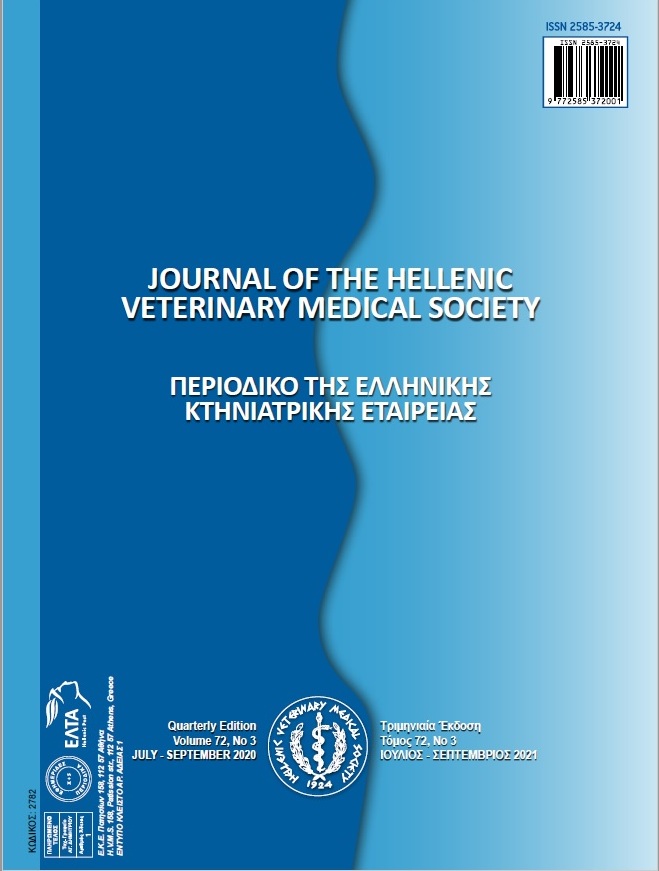Influence of dietary olive paste flour on the performance and oxidative stress in chickens raised in field conditions
Abstract
Olive oil contains a variety of antioxidants, including vitamin E. Its consumption protects against oxidative stress, which is involved in many pathological conditions, affecting animals’ development and their general welfare. The present study aimed to investigate the effect of olive paste flour (OPF) on the antioxidant status and performance of broiler chickens raised in field conditions. Total of 18.000 broilers was randomly allocated in equal numbers in two poultry houses. The chickens were grouped according to their diet as follows: Control group: chickens fed commercial poultry feed, and OPF group: chickens fed control dietsin the starter period, but they got a supplement of OPF in grower, and finisher 1 and 2periods, respectively. The birds were raised under identical field conditions (ventilation, vaccination, lighting, etc.). Antioxidant status was assessed by measuring the concentration of vitamin E in plasma, as well as the total antioxidant capacity (TAC) in plasma and muscle tissue. According to the statistical analysis of the results, the addition of OPF to chickens’ diet significantly enhanced plasma α-tocopherol concentration (p≤0.05). TAC did not show any significant differences in chicken plasma nor muscle tissue(p>0.05).Feed intake (FI) was higher in OPF group, while Body weight (BW) was lower. Liveability was similar for the two groups. The feed conversion ratio (FCR) was higher, and the European production efficiency factor (EPEF) was lower in broilers of the OPF group compared to those of the control group.Samples of roasted breast from chickens of both groups were used for organoleptic characteristics evaluation. Results showed that samples of the OPF group smelled more intensely and were more tasteful than those of the control group.However, other organoleptic characteristics did not differ. In conclusion, the results demonstrated that although the addition of OPF to chickens’ diet can cause growth retardation, it can significantly increase the plasma α-tocopherol concentration. Further studies are needed to optimize the concentration of OPF in poultry feed in order to avoid growth retardation or even to promote growth in broiler chicks.
Article Details
- Come citare
-
FOTOU, E., MOULASIOTI, V., ANGELIS, I., TSIOURIS, V., PATSIAS, A., TELLIS, C., MOUSSIS, V., BOTI, M., & TSOUKATOS, D. (2021). Influence of dietary olive paste flour on the performance and oxidative stress in chickens raised in field conditions. Journal of the Hellenic Veterinary Medical Society, 72(3), 3239–3248. https://doi.org/10.12681/jhvms.28520
- Fascicolo
- V. 72 N. 3 (2021)
- Sezione
- Research Articles

Questo lavoro è fornito con la licenza Creative Commons Attribuzione - Non commerciale 4.0 Internazionale.
Authors who publish with this journal agree to the following terms:
· Authors retain copyright and grant the journal right of first publication with the work simultaneously licensed under a Creative Commons Attribution Non-Commercial License that allows others to share the work with an acknowledgement of the work's authorship and initial publication in this journal.
· Authors are able to enter into separate, additional contractual arrangements for the non-exclusive distribution of the journal's published version of the work (e.g. post it to an institutional repository or publish it in a book), with an acknowledgement of its initial publication in this journal.
· Authors are permitted and encouraged to post their work online (preferably in institutional repositories or on their website) prior to and during the submission process, as it can lead to productive exchanges, as well as earlier and greater citation of published work.



